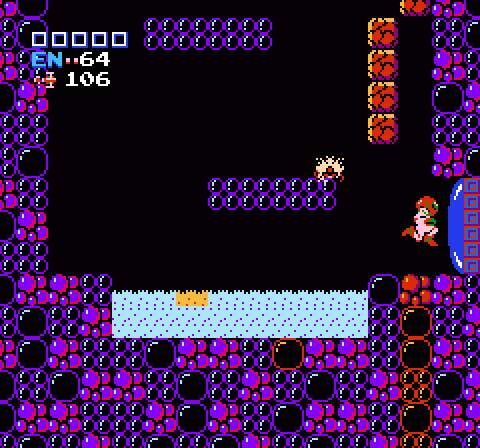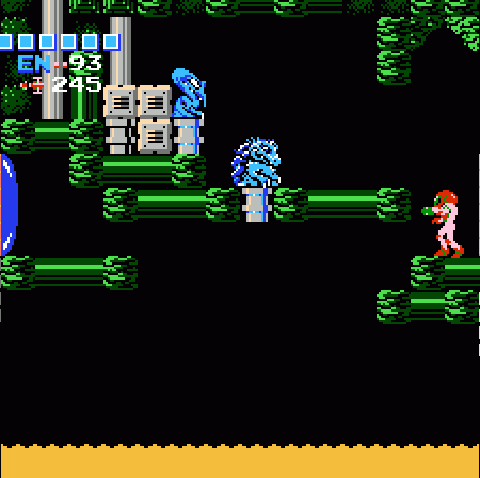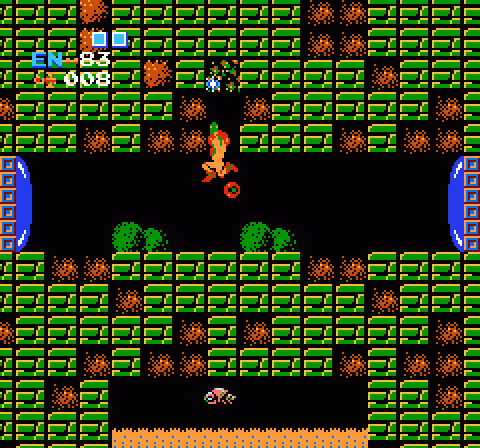So that’s Metroid done the right way. Part of what makes Metroid so fun, though, is the way it lends itself to being played the wrong way. Like a lot of games at this sort of mid-grade 8-bit technology level, Metroid contains a fair few glitches and bugs that don’t render the whole thing unplayable but rather make it more interesting. Metroid‘s underpinnings are complex enough that some things don’t work quite the way they’re supposed to, but simple enough that when the game goes looking for elements in the wrong part of memory or whatever it can still keep plugging away… albeit in a manner the developers never intended.
You see the same thing in Super Mario Bros. and Pokémon Red/Green/Blue as well. Unlike contemporary games, which are complex enough to contain advanced bug-checking filters or else simply fall apart when something goes wrong, Metroid bounces back when you hit it with unexpected data. It keeps on truckin’. As such, some of Metroid‘s glitches have become legitimate elements of many players’ arsenal.

A lot of Metroid‘s instability comes from the developers’ determination to push the NES hardware in never-before-seen directions. You can see the game struggling to keep up in the course of normal play; discolored scenery like this, for example, reportedly comes from the program code attempting to render scenery faster than it’s properly able to keep up with, meaning that when you dash into a new area or plummet down a shaft at full speed, the game struggles to keep up and eventually just says, “Well, good enough.”
Also unique to Metroid are a number of odd little game design oversights that the creators either didn’t catch or didn’t have time and resources to clean out before launching. For instance, one of the best-known quirks of the game is the way enemies, which normally are contained within the rooms in which they spawn, can be drawn into open doors at the same time as Samus’ transition from one room to another. Normally, this is a nuisance, since she remains vulnerable despite the player being out of control of her actions — meaning she takes unavoidable damage during what should be “down time.” But in some cases, you can do weird things.
For instance, you can lure standard enemies into boss battles. This doesn’t have any real impact on the game, but there’s a certain charming novelty in seeing a Waver or Reo flutter around while you’re blasting Ridley point-blank in the groin.

Of much greater value, however, is the ability to lure a Reo into the statue room immediately after acquiring some Missiles and the Bombs. Blast open the red door at the upper-left corner of Brinstar, pull a Reo into the room as you head left, and get it to fly down into the lower portion of the room and into the water/acid/whatever. Freeze it while it’s at the water’s surface, do a bomb jump off its back, and you can roll into Tourian long before you should be able to. This is a key tactic in a lot of speed runs of the game, although you’ll probably get pasted by Tourian’s hazards pretty quickly if you try doing this outside the confines of a tool-assisted playthrough. Still, it’s there, and that’s rad.
The bomb jump factor, of course, is another part of the game — an exploit that actually could be intentional. Because the explosion of a bomb propels Samus slightly upward and she can drop multiple bombs at any given time, you can harness this element of the game physics to allow Samus to “ride” the crest of sequential bomb explosions upward. With the proper timing, there’s actually no limit to how high she can reach provided she doesn’t hit an enemy… though it takes a steady hand to sustain a bomb jump for long.
Curiously, bomb jumps seem to be a specific feature of the NES version of the game; I’ve found ports like the 3DS Virtual Console rendition of Metroid, despite being ostensibly accurate to the original game, make bomb jumps vastly harder to pull off. I don’t think this is a deliberate action on Nintendo’s part to quash the exploit, though. More likely it’s simply a matter of the different hardware and interface timing.

As a corollary to the bomb jump, Samus can also use a related technique by exploiting the fact that bombs propel Samus regardless of her pose at the time of the explosion and the fact that she can jump from her “neutral” animation frame. Drop a bomb and immediately stand up, and when the bomb explodes it will send Samus flying upward slightly without changing her pose. This means you can jump in midair (years before the Space Jump!) and reach areas that might otherwise have been slightly out of reach.
Of course, the greatest technique of all is the wall climb skill, made famous by the Nintendo Fun Club Newsletter. An arcane combination of the behavior of blue doors — they seal back up a few seconds after being opened — along with the way the screen centers on Samus’ position and the physics of rolling into Maru-Mari form allows you to “climb” to new areas. When a door closes over Samus, she effectively becomes lodged in the scenery, though since she’s rendered immobile the only thing you can really do when trapped in a door is shoot it open again… or roll into a ball.
If you simply roll into a ball, well, you’re screwed. The bombs won’t open a door, and you can’t stand back up. But if you immediately stand after ducking, something about the animation makes it possible to rise again — and not only will Samus stand, she’ll actually be situated one block of the wall higher than before ducking. Repeat this rapidly and Samus will slowly climb the inside of the wall and off the screen. However, if you tap jump rapidly, her attempts to leap will cause the screen to slowly readjust to place her at the center. With an alternating combination of ducking/standing actions and rapid jumps, Samus can climb any vertical chamber.
This has incredible value in certain areas; I used it in my playthrough to reach the Varia long before I had the Ice Beam and High Jump. In others, it can be deadly. You need to reach another blue door in order to escape the wall, so if you climb a room with no door in the wall above your starting position, well… that’s a shame.
But it’s also possible to go into Metroid‘s equivalent of Super Mario Bros. “minus world” — areas above the actual boundaries of the current map. Here, you may be able to find shafts that shouldn’t exist, rooms that beckon for exploration, strange mishmashes of graphics and color palettes, and more. Most of the time you’ll simply reach a dead end and die, but until fans at sites like Metroid Database sorted out the particulars of Metroid‘s “secret worlds” and determined that they were just buffer overflows and misplaced data pointers, many speculated that the creators had hidden away deliberate secrets — new areas to explore, additional goodies to acquire. But, no.
It doesn’t matter, though. Metroid‘s oddities and errors have become an integral part of its legacy — unintended features embraced by fans. While sequels smoothed them out one by one, the series’ stewards have paid tribute to this part of Metroid‘s heritage in various ways… perhaps most notably with Metroid Fusion‘s dead-end “shinespark” sequence break.
And… that’s it for Metroid. I’ll be hitting the sequels, eventually, but next up: Something very different… but somewhat related.
…Kid Icarus?
Kid Icarus?!
Blaster Master? I never “got” why people liked that one so much, but it is in the Metroid vein.
I’ve read through a bunch of the other Anatomy of a Game articles, but this is the first one I’ve had the chance to read as it went up. I really love the analysis you put into these articles and they’ve made me think about the games they covered in ways I’ve never considered. The one for the first Castlevania made me go out finally decide play where before it was on my list of “I should get around to this one day” games. I look forward to whatever game you have in store for us next.
This recent post on Metroid and the password system is relevant: http://minimaxir.com/2013/05/its-a-livin/ Back when I was a little kid, the existence of passwords in games like Metroid and Castlevania 3 blew my mind. Clearly, I was not clever enough to come up with concepts like hashing and encoding on my own.
Breaking Bad is going to be killer, no? August can’t get here fast enough. I also never noticed this before, but does Samus (in suit) sometimes look kinda like the Space Jockey of Alien fame?
She doesn’t, but Mother Brain does.
I wonder why Metroid was the only NES game to have background discoloration problems.
Metroid wasn’t the only one. I’ve seen several NES games with BG discoloration problems.